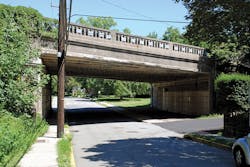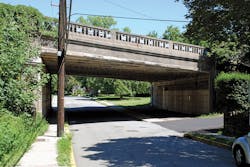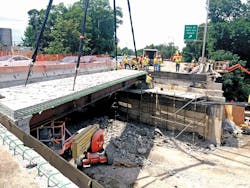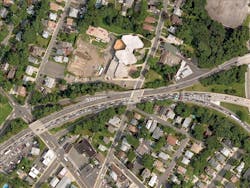In the shadow of the GWB
Fort Lee, N.J., is home to the second-worst traffic bottleneck in the country according to the American Transportation Research Institute.
This ongoing pain point was evident during the evaluation of a bridge handling 63,000 vehicles every day and serving as a connector to the nearby George Washington Bridge.
Principal arterials U.S. Rte. 1/9 and Rte. 46 cross over Jones Road in Fort Lee Borough via a 60-ft-long single-span bridge. Structurally deficient and deteriorating at a costly rate, the 87-year-old bridge did not meet growing traffic demands. As a result, the New Jersey Department of Transportation (NJDOT) faced a serious dilemma—how to fix a bridge that feeds heavy commuter traffic into a major thoroughfare and serves a tight-knit local community, without adversely impacting motorists.
NJDOT’s contracted project team developed an innovative maintenance and protection of traffic (MPT) plan and used time-saving accelerated bridge construction (ABC) techniques for the $4.3 million federally funded bridge reconstruction. ABC methods incorporate combinations of innovative designs and construction techniques to minimize the amount of time traffic is disrupted during construction. Many ABC projects, including this one, incorporate prefabricated bridge components that are shipped and assembled on-site. The prefabrication significantly reduces on-site construction time, resulting in shorter traffic disruptions compared to traditional bridge construction methods.
“This ABC project demonstrates how stakeholder collaboration, combined with innovative design, construction, and traffic maintenance planning, can alleviate workday and school district travel congestion while also prioritizing the safety of travelers,” said Jay Jeyamohan, project manager for NJDOT.
The 87-year-old bridge over Jones Road was structurally deficient and did not meet growing traffic demands.
Design meets needs
The U.S. Rte. 1/9 & 46 bridge supports four lanes of highway traffic over a local road. Constructed in 1930, the existing bridge was a single-span structure consisting of concrete-encased steel beams supported on full height abutments. While the two outer fascia girders were oriented parallel to the centerline of the bridge, all interior stringers were oriented orthogonally to the highly skewed (30°) abutments. Several stringers were framed into the sides of the existing fascia girders, creating a stringer/floorbeam configuration. NJDOT classified the bridge as structurally deficient because its deck was in an advanced state of deterioration caused by many years of service. To remedy that classification, NJDOT contracted with Gannett Fleming to design the required improvements. NJDOT awarded the construction contract to the joint venture of J. Fletcher Creamer & Son Inc. and Joseph M. Sanzari Inc.
NJDOT chose to address the deficient bridge deck through an entire superstructure replacement, while maintaining the current footprint and repairing the substructure. A complete superstructure replacement also provided an opportunity to realign the new beams with the roadway above to eliminate the stringer/floorbeam configuration and simplify future deck replacements.
Traffic demands and site constraints eliminated the possibility of a full closure during construction, so a staged half-width replacement scheme was required. Half-width construction is very difficult when the existing beam lines do not align with the supported roadway above, as the beam lines cross the staging lines. To overcome this problem, temporary supports would need to be provided under all beams that cross the staging line. This would allow them to be cut along the staging line such that the portion of the beam located in the work zone could be removed while the portion on the opposite side of the staging line could temporarily remain in service to support the roadway above.
It was clear early in design that the proposed half-width scheme would adversely affect roadway capacity during construction. In addition, all work would have to take place during the summer to accommodate the public school located adjacent to the bridge site. The project team devised an ABC solution to minimize the on-site disruption.
The replacement superstructure consisted of seven prefabricated superstructure units (PSUs), with each unit comprised of two rolled-steel beams connected by a precast concrete deck. Gannett Fleming designed and detailed the PSUs to orient the new beams parallel with the roadway, simplifying the bridge framing and better accommodating future maintenance operations. Other innovations used to accelerate construction included the advanced construction of concrete pedestals on the abutment seats prior to staged construction operations, and attachment of the bearings to the steel beams prior to arriving at the site. The team rehabilitated the existing abutments in order that they remain in service.
Combining PSUs with temporary supports allowed the existing superstructure to be replaced with minimal impact to traffic. NJDOT reduced the traffic lanes on the mainline highway only two weekends during replacement thanks to staged operations. The weekend operations took place during the summer of 2017 when school was not in session. Although the need for temporary supports required implementation of a full detour for the roadway below, it was not considered a significant impact to the local community because of the bridge’s location in a highly urbanized area. Alternate routes around the project site were very short.
The project consisted of four main construction stages. Stage 1 included preparatory work necessary to support the upcoming weekend lane closures, including the installation of the temporary supports below existing beams crossing the staging line, the construction of new pedestals on the existing abutment seats and utility relocations. During stage 2 the project team replaced the north side of the bridge over one weekend while maintaining two lanes of Rte. 1/9 northbound and Rte. 46 eastbound on the south side of the bridge. Stage 3 occurred the following weekend, during which time the project team replaced the south side of the bridge while maintaining one lane of Rte. 1/9 northbound and Rte. 46 eastbound on the north side of the bridge. Keeping the northbound lanes continuously open and maintained during construction allowed typical George Washington Bridge traffic to flow. Route 1/9 southbound and Rte. 46 westbound were closed over both weekends, and travelers used I-95 southbound as a detour route. Thanks to strategic coordination with the New Jersey Turnpike, I-95 accommodated the rerouted traffic over the two weekends.
Cleanup and restoration work comprised off-peak hours in stage 4.
Site constraints eliminated a full-closure possibility during construction, so a staged half-width replacement scheme was required.
Lines open
Extensive coordination was necessary among the design, construction and inspection teams, third-party utility companies, two local boroughs, the Fort Lee School District, and state transportation agencies. NJDOT required a collaborative design and construction approach that impacted the fewest travelers possible because the bridge is located beside an elementary school, near a daycare, and within a residential area.
NJDOT’s Public Information Center encouraged community involvement and enabled residents to receive pertinent project updates through presentations and open houses. Satisfying the superintendent of Fort Lee School District was of upmost importance to the project team, as the elementary school is less than 100 yd from the project site and adjacent to the bridge. The school district expressed relief at the project team’s decision to use ABC because traditional construction methods would have hindered access to the elementary school. Instead, construction took place during the summer months to avoid the need to reroute school buses or inconvenience teachers and families.
To best serve residents and visitors while implementing the MPT, the project team worked with the Port Authority of New York & New Jersey, New Jersey Turnpike Authority, and Transcom, a coalition of 16 transportation and public safety agencies in the tri-state region. Together, the agencies and the project team identified six routes motorists could take to avoid the 1/9 & 46 bridge during construction.
The project team installed dynamic and variable message signs throughout the impacted area to enhance motorist awareness of alternate routes during the construction phase and notified travelers in advance of all traffic pattern changes.
This successful collaboration demonstrates the benefit to working diligently with the public across numerous organizations.
U.S. Rte. 1/9 & 46 are principal arterials that cross over Jones Road in Fort Lee, N.J., via a 60-ft-long single-span bridge.
Honoring history
Members of the community expressed their desire to preserve the charm of the existing bridge. The project team was able to maintain the architectural features that were most visible from Jones Road by rehabilitating the existing abutments. This included the abutment wall scoring as well as the ornamental treatments located at the abutment corners. Since the existing bridge’s fascia beams were parallel to the mainline, the reconfigured framing was not obvious on the façade of the reconstructed bridge. However, the project team found it necessary to incorporate form liners on the outside of the new parapets to replicate the existing bridge balustrades. These measures provided the community with a design that achieved traditional aesthetic appeal and met New Jersey Historic Preservation Office requirements.
Given its importance to the community and its proximity to the George Washington Bridge and Manhattan, the bridge over Jones Road presented a critical challenge to NJDOT. The need to preserve the historic charm of the bridge, heed stakeholder concerns about access to the school and surrounding community, and reduce the impact in the already-congested New York suburb, led to the decision to use ABC techniques. NJDOT completed the Rte. 1/9 & 46 bridge over Jones Road superstructure replacement project in October 2017.



